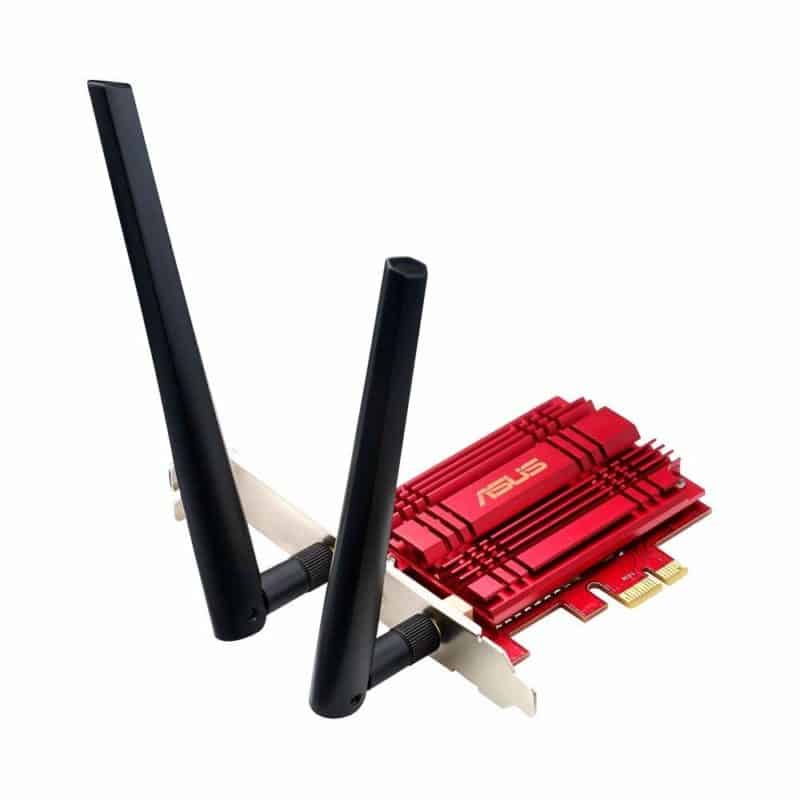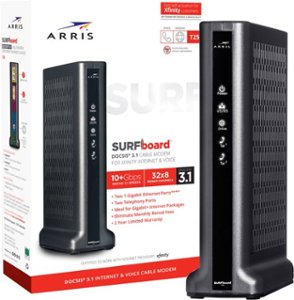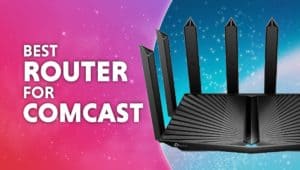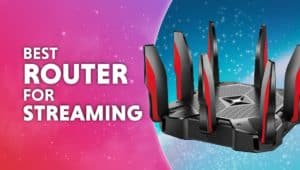Best PCIe WiFi cards for gaming 2024 – our top 5 picks
We Pick The Best Wi-Fi Cards For Gaming Currently Available

WePC is reader-supported. When you buy through links on our site, we may earn an affiliate commission. Prices subject to change. Learn more
Over the past couple of decades, the technology industry has gone a bit bonkers for wireless compatibility. So the best PCIe WiFi cards for gaming will be key for a good speed. We’re seeing more wireless mice, headsets, and keyboards than ever before, mainly thanks to new, more cost-effective ways of removing the hassle of cables.
With that being the case, it’s no surprise that more and more people are now wanting to remove the hassle of cables when it comes to their internet needs as well. PCIe Wi-Fi cards have been growing in popularity exponentially over the past couple of years, with the marketplace now offering a sea of affordable options for all levels of performance. That makes choosing the best PCI-e Wi-Fi card for gaming all the more difficult.
Best PCIe WiFi cards for gaming in 2024
With a good number of PCIe WiFi cards currently on the market, we thought we should help find your best option. We go over our top picks and more in greater details – discussing pros, cons, and everything in between.
GIGABYTE WiFi 6E GC-WBAX210

GIGABYTE WiFi 6E GC-WBAX210

Wi-Fi Speed
Up to 2400 Mbps (6E)
Bluetooth
Version 5.2
Wireless Technology
WiFi 6E, 5Ghz, and 2.4 GHz
- Latest and fastest WiFi protocol
- Small and easy to install
- Well built and cooled to continue good signal without throttling
- A bit more expensive than other options
If you’re looking for the top-end choice of speed and you have the hardware to match, then having a 6E-compatible WiFi card for your router is important. You need to have both at the same protocol to get the benefit and as such the Gigabyte WiFi 6E GC-WBAX210 is a great choice. Even with its very catchy name, it does give the optimal speed.
The PCIe WiFi card offers the top range of speeds when capable, as the protocol is the emptiest band at the moment so you can benefit from the speed. And this card along with Bluetooth does give you a good connection and features.; Along with a good cooling shroud that won’t throttle your speeds with prolonged use. As well as a good antenna with tilting and magnetics.
Now with the 6E usage and the 2×2 802. 11ax the GC-WBAX210 boasts a speed of up to 2400 Mbps, so it will be just like a wired connection. But you do have to have the hardware already in place to support it, like a 6E router.
ASUS PCE-AC56 PCI Wireless Express Adapter
ASUS PCE-AC56 PCI Wireless Express Adapter
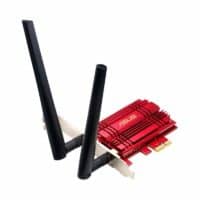
Standard
IEEE 802.11 a/b/g/n/ac
Frequencies
2.4Ghz or 5GHz
Connection
PCIe
- Prioritizes data transfer
- Large wireless coverage
- Excellent speeds
- Does not support Linux
The ASUS PCE-AC56 gets the number one spot for PCIe Wi-Fi card for gaming and it’s easy to see why. The AC56, as we’ll call it, not only provides excellent speeds and overall performance, but it also brings a ton of reliability to the table as well.
The ASUS PCE-AC56 offers dual-band operations and supports transfer speeds up to 876Mbps (5GHz) or 400Mbps (2.4GHz). Alongside this, ASUS has equipped it with various modulation technologies, including OFDM, DQPSK, CCK, DBPSK, 64QAM, and 16QAM, all helping to improve performance whilst allowing for data transfer prioritization.
Thanks to the two external antennae, locating the perfect position from your laptop/PC to your router couldn’t be easier. Pairing this with the wide range the AC56 supports you can pretty much put your computer wherever you want.
The easy-to-install AC56 is compatible with most versions of Windows and adds a certain level of aesthetic appeal to your build. Take all these factors into consideration, alongside the powerful heatsink it comes equipped with, and you have a superb little PCIe Wi-Fi card for your next build.
TP-Link AC1300 PCIe Wifi Card
TP-Link AC1300 PCIe Wifi Card
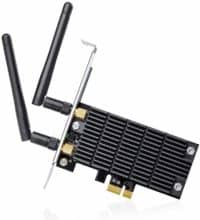
Standard
IEEE 802.11 a/b/g/n/ac
Frequencies
2.4GHz + 5GHz
Connection
PCIe
- High quality range
- Excellent heatsink for the price point
- Doesn’t offer great speeds
If you’re looking for wide coverage, solid signal strength, and an affordable price tag, look no further. The TP-Link AC1300 PCIe Wi-Fi card is a well-balanced mix of all three, bringing the reliability of TP-Link’s name with it.
This particular adapter offers up speeds of 867Mbps in the 5GHz range and 400Mbps in the 2.4GHz range, putting it bang in line with the top performers in this guide. Speeds of this height are going to be more than enough to play most gaming scenarios, alongside excellent streaming and browsing results too.
Whilst the two external antennas aren’t the best in the world, they do provide adequate range reception for your Wi-Fi – allowing you more freedom when choosing a location for the game. The heatsink on the AC1300 is up there with the best in this guide, providing excellent thermal dissipation whilst in use.
This model supports most versions of Windows – including Windows 10. However, that being said, it, unfortunately, does not cover Linux. Overall, it’s still one of the best Wi-Fi cards in today’s market – and a damn good value one too.
Ubit WiFi 6E Supports 6GHz 7th Generation PCIe WiFi Card
Ubit WiFi 6E Supports 6GHz 7th Generation PCIe WiFi Card

Wi-Fi Speed
2400 Mbps @ 5GHz , 574 Mbps @ 2.4GHz
Bluetooth
5.2
Max Speed
2402 Mbps @ 6GHz , 2402 Mbps @ 5GHz , 574 Mbps @ 2.4GHz
- Wifi 6 – Supports fastest Wi-Fi available.
- Bluetooth 5.2 – Faster than 4.2, with broader coverage.
- PCI-e 4.0 – Low latency device communication.
- Concurrent Bluetooth Device Support – Can be used by multiple devices and apps at the same time.
- Price – You’re paying for more than the Bluetooth adapter.
Ubit’s 7th gen Wi-Fi card offers a combination of high transfer speeds and a lag-free experience, making it a fine choice for gamers of all genres. It is also the only card in this list that comes equipped with a cabled antenna system, giving it a slight edge in the range department.
The AX210 card comes equipped with two detachable antennas that connect to the Wi-Fi card via a screw system at the rear. Users are offered a dual-band frequency with the Ubit Wi-Fi card, providing around 2400Mbps in the 5.0GHz range and 574Mbps in 2.4GHz – both of which are ample to support most gaming needs. Furthermore, this Wi-Fi card comes with a BlueTooth 5.2 connection, allowing you to easily connect to compatible devices if you wish.
Overall, when you consider all the factors involved, we consider the Ubit 7th Gen Wi-Fi adapter to be fantastic value for money – easily one of our top picks in this category.
Rosewill RNX-AC1900PCE
Rosewill RNX-AC1900PCE
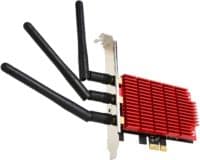
Standard
IEEE 802.11 a/b/g/n
Frequencies
Dual band (2.4Ghz or 5GHz)
Connection
PCIe
- Very easy to install
- Decent transfer speeds
- Good coverage
- Did experience some driver issues
If you’re looking for a fast-performing PCIe Wi-Fi card but don’t have the cash to splash out on one of the premium offerings, fear not, Rosewill has you covered. This, their RNX-AC1900PCE, is a superb combination of performance and affordability. It’ll provide you with all the speed you require to run games efficiently, alongside a wide range and good quality antennae.
As far as speeds go, the AC1900 provides a handsome 1300Mbps on 5GHz range and 600Mbps on 2.4GHz – both extremely good for the price point. The AC1900 comes equipped with three detachable, omnidirectional antennas which are one of the main factors that contribute to its great performance. They make finding a clean, strong, and interrupt-free location for your PC/laptop very easy indeed.
As far as support goes, the AC1900 was extremely easy to install and worked with most Windows-based systems. That being said, there have been documented cases of this Wi-Fi card not working with Windows 10 systems. We, however, encountered no issues whatsoever.
Things to consider before buying a PCIe WiFi card for gaming
Like all hardware components, choosing the best PCIe Wi-Fi card for gaming requires certain levels of consideration to ensure you choose the right one. As the market is currently flooded with a sea of options, it can sometimes be difficult to choose the one that best suits your setup.
For that reason, we’ve put together the main aspects of a Wi-Fi card that should always be considered prior to purchase. These will cover the main factors that affect you from a performance and gaming standpoint.
Data transfer speed and bandwidth
Data transfer speed and bandwidth a hugely important aspects when it comes to gaming, especially for those who like to play more competitive titles. The speed and bandwidth of your WiFi card will dictate how quickly you’ll receive your internet connection. For gamers, you want to choose a data transfer speed that covers the speed of your internet.
The speed of your Wi-Fi card is a combination of several factors working together, but ultimately all comes down to the demands of your network. A Wi-Fi card that works well for your work colleague might not work as efficiently for you. There is a variance between download and upload speeds so those won’t come at the same level. Especially depending on your own home network how well It is setup and its connectivity./
That said, any PCIe Wi-Fi card worth its weight will provide adequate speeds for a gamer and their household. As a base figure, gamers should be looking for at least one Gigabit of data throughput. This is more than enough speed to accommodate your gaming/browsing needs. However, for those looking to achieve the highest levels of wireless connectivity, two and three-gigabit Wi-Fi cards are available. Make sure to fit those GHz bands and get the best download speeds.
Encryption is also key over radio waves. The use of WPA over WiFi is standard and a more modern option is good for the standard. This may be carried by the chipset and how new the card is, especially when you have no ethernet cable to be used and you’re sending out your data.
Number & quality of antennas
The antennas that come attached to your WiFi card are probably much more important than you would initially think. Firstly, the antennas are the feature of a WiFi card that transmits and receives the data given out by your wireless router. That makes them hugely important in the greater scheme of things. Whilst the quality of the antenna is extremely important, so is the number of antennas that your Wi-Fi card accommodates.
Each of the antennae on your Wi-Fi card can transmit and receive data. So, having more high performance antennas theoretically means you can receive more data. Furthermore, positioning your antenna in different directions can increase the coverage of your wireless connection.
However, it isn’t all about quantity – we’ve also got to consider quality. The marketplace is a sea of Wi-Fi card options, many of which try to claim your cash by offering ‘bang for your buck’ price tags – achieved by reducing the quality of certain features. That said, if you are serious about wireless gaming, you must factor in the quality of your antennas.
The quality of your antennas will dictate certain characteristics of your Wi-Fi card, including signal strength, signal distance, speed, bandwidth, and overall coverage. When purchasing a Wi-Fi card, try and discover what antenna the manufacturers have used. If they’re unimpressive stock antennas, you might want to consider replacing that. As with the wireless network cards, the signal reception may be improved with more antennas and limit the interference you experience.
Thermals
Like most PC components, thermals and cooling are some of the most important things to consider when it comes to gaming. If thermals start to increase, you see a rapid decline in the efficiency of that hardware component. The same can most definitely be said for Wi-Fi cards – the main reason why you’ll often see them equipped with fair large heatsinks.
Ultimately, if you want the best Wi-Fi experience, look for an adapter that comes equipped with a fairly good-sized heatsink. This will ensure that your Wi-Fi card is running in optimal conditions.
Size
Whilst the size of your Wi-Fi card doesn’t actually have a direct correlation with gaming performance, it can affect you in other ways. For example, if your Wi-Fi card is too large, you might end up blocking other more important hardware components – such as the GPU.
Just keep in mind how much available space you have to play with when purchasing a Wi-Fi card. The last thing you want to be doing is sending stuff back and restarting your search.
There may be variations in the low profile bracket option if you are fitting it into a smaller desktop. These tend to be low-profile PCIe wireless cards that don’t take up much room in your build. Especially when it comes compared to the large 4-slot graphics cards.
WiFi protocol
Another thing is the compatibility or which version of WiFi you are using between the router and the WiFi card. You want to make sure that you’re not missing out on any performance and speed between the two devices.
So if you’ve already got or planning on getting a 6E router, you want to make sure you have a PCIe WiFi card to match. You want to make sure you can take advantage of the faster and less traffic full protocol. Which will make sure you get the most out of your devices. Ranging in the MHz channels with the wireless cards gives you a good ultra-low latency options.
Final word
So, there you have it guys, our comprehensive rundown of the best PCIe WiFi cards for gaming in 2024. We hope this article has shed a little light on a topic that is sometimes overlooked. We’ve tried to break the technology side of things down into easy-to-digest pieces of info that could actually aid you in your next best WiFi card selection.
FAQs
Is a PCIe WiFi card worth it?
Yes, when it comes to choosing Wi-Fi for your gaming PC, a PCIe Wi-Fi is certainly one of the best options you can choose. It connects directly to the motherboard, and given this, it tends to provide particularly great and fast speeds.
While it does provide a good connection and speed overall, if you need to connect this yourself, and you have no real experience with where it needs to go and how to open the PC case for example, this may not be the best option for you.
However, the power and connection it can supply is fantastic. The majority of PCI Wi-Fi adapters feature two or more antennas to ensure that the connection remains stable. On the whole, PCIe Wi-Fi tends to be better than USB Wi-Fi, and is the preferred choice in the vast majority of cases. But its still less reliant that an ethernet connection straight.
Are PCIe WiFi cards better than USB?
Yes, PCIe Wi-Fi cards are better than USB for a number of reasons. While they are both good options, Wi-Fi cards do tend to be faster, and more responsive.
Given that PCIe Wi-Fi cards have antennae, they tend to pick up a stronger Wi-Fi signal in comparison to USB. This is something that is important, especially if you are streaming games or playing them online. The last thing you will want is a bad signal.
In addition to being fast and better for connectivity, the PCIe Wi-Fi card connects straight to your motherboard, whereas a USB connects to the USB port. If you have space USB ports, then this will not be a problem for you. However, if you have a limited amount of USB slots, having to use an extra one for your Wi-Fi can potentially be a problem.
The only issue with PCIe Wi-Fi cards is that they are a little trickier to install in comparison to USB ports. If you are looking for the easiest option overall, the USB may be better.
Where do you put PCIe WiFi card?
As we have mentioned in this article, the PCIe Wi-Fi connects to a specific part of the PC. Instead of connecting via a USB port like the USB Wi-Fi, it connects directly to the motherboard. Given this, you will need to open your PC case and locate where it needs to be connected.
It is fairly easy to locate the connection point, but if you are new to the PC tech world, you may not know where this is. To begin with, turn off your PC and open up the PC case.
You will then need to locate a space PCIe slot on the motherboard itself. The PCIe slots are raised from the motherboard and are fairly easy to spot. Once you have chosen the slot, you will need to remove the back panel behind the slot in order for the antenna to be placed outside the PC case.
Once you have done this, you will simply need to push the Wi-Fi card into the case, and it will be ready to use.
Can you put a WiFi card in a PCIe x16 slot?
Whether the Wi-Fi card can be placed in a PCIe x16 slot is all dependent on the Wi-Fi card itself. While some are compatible, others are not. Typically, you would use a PCIe x16 slot to connect your GPU to the motherboard. So, if you only have one of these slots, you will want to keep it for your GPU. Using an x16 slot for this purpose is not really necessary, but it is possible for many Wi-Fi cards.





